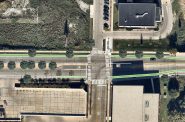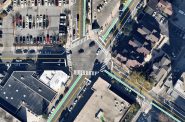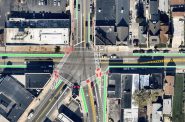76th and North, a Lost Opportunity
The intersection should be Tosa’s symbolic center, rather than something to rush through.
While Wauwatosa is a diverse patchwork of different neighborhoods and uses, the intersection of 76th and North seems to be its true center, even with the large physical divides created by I-45 and the Menomonee River. The corner quite literally is at the center of the city’s civic and municipal operations and is also home to a bank, a middle school and a retirement community.
However, the intersection itself feels overbuilt and awkward, unfriendly to pedestrians and bikes, and just generally dated. Pork chops – the nickname for small pedestrian islands between the through-traffic lane and right-turning lane — are present on all four corners, and those are usually a no-go when trying to create space meant for non-vehicles. While North Avenue has experienced an exciting renaissance in either direction of this junction, with a superb adjoining redesign going east, this intersection remains a sunbaked disappointment. 76th Street south of North Avenue – actually called Wauwatosa Avenue – is a pleasing street even with its periodic congestion issues. Lined on either side with mature old growth trees and turn-of-the-century homes, it runs through one of the nicest neighborhoods in the region. With all of these components in mind, it’s surely possible to change 76th and North so it successfully ties together two thriving business districts and a civic center, while accommodating seniors and students in a way that is pleasing to the eye, safe for all, and convenient to drivers.
What works?
The intersection is located in the center of a well-populated suburban community that is rich with businesses and activities. Both roads carry substantial amounts of traffic, and the civic presence of this place also makes it a destination for many Wauwatosa residents, meaning we have a place that has purpose, with the potential to be redesigned into something striking that positively impacts its users. Traffic flow, while often congested, is heavy and speed limits leading to this place are relatively low meaning that creating a pedestrian-friendly atmosphere should be relatively easy as Wauwatosa has already done great work modifying and improving North Avenue between 60th and 76th. Wauwatosa is a great community that has shown continued commitment to progressive urban planning and development. Ultimately this is a promising location that connects several regional destinations. It’s a junction of two prominent thoroughfares and its overhaul would have a direct positive impact on many thousands of people.
What doesn’t?
The intersection generally feels overbuilt and inhospitable compared to the relatively narrow and compact streets that lead into it. North Avenue opens into three lanes in either direction as it meets with 76th and this doesn’t really make sense seeing as it narrows down to one active traffic lane in either direction as it reintegrates into the urban fabric. It makes no sense to widen the road as it approaches the intersection only to narrow it once again upon exit, creating bottlenecks for drivers and an unsafe situation for bikers. A small grass median exists west of 76th Street; this is unnecessary and only contributes to the imposingly wide gap between the library and Longfellow Middle School. In an area where children and their safety should be emphasized, this widening only makes crossing the street more difficult and encourages people to accelerate at the very time they should be slowing.
76th Street north of the intersection also fails in that it widens upon approach and encourages traffic to speed up and through the intersection, only to continue on to one active traffic lane in either direction on Wauwatosa Avenue. The library entrance on Wauwatosa Avenue also provides an additional risk as drivers try to come in and out of the municipal parking lot. Whereas bike lanes are so clearly demarcated on North Avenue, they all seem to disappear upon approach to this area where they are most necessary. The village has proven that they can do a great job; here it needs to mark those bike lanes and pedestrian crossings.
How can we improve it?
A few things come to mind as you look at this intersection. Every building is set back from the street that gives us room to be a bit more creative in solving this issue. With that, I think our first steps would be to narrow North Avenue to two lanes of active traffic in either direction down from three and to add bike lanes to the street. I would keep Wauwatosa at one lane of active traffic in either direction and narrow 76th street to one active lane and one parking lane in either direction. I would repave the sidewalks along all four blocks leading into the intersection; add street trees and decorative lighting as is seen on E. North Avenue to continue an established aesthetic of the city. All these improvements would need to be done on all four blocks that leading to the intersection.
I think that a roundabout would be the best solution for the intersection as there is room to build one, it would slow traffic dramatically, and would allow for a central circle where a distinctive fountain or piece of public art could be installed with the goal of creating a place that marks the center of the village. The goal is not simply a roundabout, but a pleasant and dignified meeting place of prominent avenues. Wauwatosa’s main intersection will no longer feel like a missing space between important components, it will tie all the pieces together and become a place that physically embodies its importance.
Though it’s currently a signaled intersection and handles a high volume of traffic, I think a roundabout can work without signals due to the nature of its design. Some signage would be required as would a slowing of the speed limit upon approach, but the lack of signals would also allow for expedited and relatively unmitigated traffic flow. I think that the primary concern when thinking about redesigning this junction would be to think about the hundreds of students at the middle school and likely to visit the library. The benefit to the pedestrian is that in addition to lowering speeds, the roundabout means pedestrians only have to cross one direction of traffic at a time and only need to look in one direction when crossing.
The addition of signage encouraging people to yield to pedestrians would enhance the already improved safety that would come with the new configuration. I would also advocate the use of colored pavement for crosswalks rather than simply painted lines. I would encourage leading bicyclists off of the street and onto their own exclusive-use, raised lanes when passing through – they would adhere to walk signals rather than traffic lights in this area before reintegrating onto the street. Wauwatosa has the opportunity to do something bold at this intersection and tie the city together, while increasing the intersection’s safety and friendliness for pedestrians and bikers.
Intersection
-
6 Changes Needed on Commerce & North
 Aug 25th, 2017 by John O’Neill
Aug 25th, 2017 by John O’Neill
-
Farwell and Brady Need Changes
 Mar 30th, 2017 by John O’Neill
Mar 30th, 2017 by John O’Neill
-
16th And Greenfield Is Chaotic
 Feb 10th, 2017 by John O’Neill
Feb 10th, 2017 by John O’Neill





















An excellent analysis.
I’m not always against roundabouts… but I’m skeptical this is a good place for one. The total space for the amount of traffic, the uneven levels of traffic flow, and a few minor issues make me wonder if that’s really a good idea here.
It would be interesting to know what kind of property and injury collisions have occurred here in the past. I like most of your ideas but disagree with the roundabout. Roundabouts require a lot of space and are more appropriate for Mayfair Road or Burleigh west of 106th where there are high turn volumes and fewer pedestrians. With a roundabout there would be fewer downstream gaps that would aid pedestrians and motorists. The removal of pork chops could also increase the number of conflict points for pedestrians and would require longer crosswalks and longer clearance phases.
More important to the roundabout question would be the roads leading away from it. If Wauwatosa to the south and possibly North Ave to the east regularly stall or fill with cars, the roundabout becomes a parking lot.
Uh oh! The one R-word that conservatives hate….roundabout. “Not at my thoroughfare!”
SteveM- that is such an odd comment considering the Walker administration is the one that have given lucrative roundabout building contracts throughout the state, many that were not needed but built anyway (such as east of Beloit)
I would be against a roundabout as the pedestrian and runner traffic would be significantly worse and more dangerous in my opinion. Marking lanes and possibly changing the through lanes squeezing down would ups seem cheaper and more effective to safety
In general, I think roundabouts are solid solutions, but I’m not sure this is the location. Mostly, I’m curious about how they function in areas with a lot of pedestrian traffic. There are a LOT of middle schoolers crossing at that intersection several times a day. I could see parades of kids shutting traffic down completely for minutes at a time, creating real gridlock.
I also wonder about the impact buses have on roundabouts. I know, they are just another vehicle, but do bus stops need to be set further back from the intersection? Would that make it more difficult to create narrower streets?
While I do agree roundabouts are a good thing, I don’t believe it would be a good idea for this intersection. I have a brother in the roundabout industry, and at first glance he said this would have to be multi-lane roundabout due to the traffic volume there to avoid the backups. However, these types of roundabouts are not the most pedestrian friendly. A more creative solution will be needed to accommodate both the high car and pedestrian traffic.
@Malcom “shutting traffic down completely for minutes at a time, creating real gridlock.” You mean like a stoplight does? A roundabout would actually time slice those competing groups fairly well. Roundabouts generally deliver non-zero, less-than-stoplight wait times.
@Brian “would have to be multi-lane roundabout due to the traffic volume” Actually, probably the opposite. Assuming that the surrounding network is sufficient (e.g. no other stall point say one or two blocks away), a roundabout has a much higher cars-per-unit-of-time capacity than a stoplight, thus eliminating the need for those extra lanes to store cars while they wait. Extra storage lanes is what this intersection has now, and in addition to being unfriendly, they encourage race car drivers to “skip the line”, often in a more dangerous fashion (higher speeds, abrupt merges at awkward points, etc)